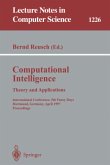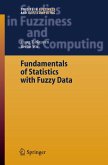This basic textbook gives an easily accessible introduction to fuzzy theory and its applications. It provides basic and concrete concepts of the field in a self-contained, condensed and understandable style. This First Course on Fuzzy Theory and Applications includes numerous examples, descriptive illustrations and figures of the basic concepts, as well as exercises at the end of each chapter. The author has long time experience in teaching on fuzzy theory and its applications and continuously developed and summarized his didactic lecture notes into this book. This book can be used in introductory graduate and undergraduate courses in fuzziness and soft computing and is recommendable to students, scientists, engineers, or professionals in the field for self-study.
Fuzzy theory has become a subject that generates much interest among the courses for graduate students. However, it was not easy to find a suitable textbook to use in the introductory course and to recommend to the students who want to self-study. The main purpose of this book is just to meet that need. The author has given lectures on the fuzzy theory and its applications for ten years and continuously developed lecture notes on the subject. This book is a publication of the modification and summary of the lecture notes. The fundamental idea of the book is to provide basic and concrete concepts of the fuzzy theory and its applications, and thus the author focused on easy illustrations of the basic concepts. There are numerous examples and figures to help readers to understand and also added exercises at the end of each chapter. This book consists of two parts: a theory part and an application part. The first part (theory part) includes chapters from 1 to 8. Chapters 1 and 2 introduce basic concepts of fuzzy sets and operations, and Chapters 3 and 4 deal with the multi-dimensional fuzzy sets. Chapters 5 and 6 are extensions of the fuzzy theory to the number and function, and Chapters 7 and 8 are developments of fuzzy properties on the probability and logic theories.
Fuzzy theory has become a subject that generates much interest among the courses for graduate students. However, it was not easy to find a suitable textbook to use in the introductory course and to recommend to the students who want to self-study. The main purpose of this book is just to meet that need. The author has given lectures on the fuzzy theory and its applications for ten years and continuously developed lecture notes on the subject. This book is a publication of the modification and summary of the lecture notes. The fundamental idea of the book is to provide basic and concrete concepts of the fuzzy theory and its applications, and thus the author focused on easy illustrations of the basic concepts. There are numerous examples and figures to help readers to understand and also added exercises at the end of each chapter. This book consists of two parts: a theory part and an application part. The first part (theory part) includes chapters from 1 to 8. Chapters 1 and 2 introduce basic concepts of fuzzy sets and operations, and Chapters 3 and 4 deal with the multi-dimensional fuzzy sets. Chapters 5 and 6 are extensions of the fuzzy theory to the number and function, and Chapters 7 and 8 are developments of fuzzy properties on the probability and logic theories.
From the reviews: "This book is published under the Springer series Advances in Soft Computing, which covers a variety of topics, such as fuzzy sets, rough sets, neural networks, and evolutionary computations. ... contains numerous illustrations of the concepts, examples, and exercises at the end of each chapter. ... an excellent book for reference as well as for studying during a course. ... This book is intended for an introductory graduate or advanced undergraduate course ... recommended for students, scientists, engineers and professionals in the field for self-study." (Zachary Richards and Haisam Osman, International Journal of Acoustics and Vibration, Vol. 14 (4), 2009)








